East Ruston Old Vicarage
|
One of the most remarkable gardens made in recent years. |
|
An Introduction to East Ruston Old Vicarage Garden
|
 East Ruston Old Vicarage
East Ruston Old Vicarage is one of the most remarkable and enjoyable gardens made in recent years. Created by Alan Gray and Graham Robeson, now 15 years old and expanding at a rate of knots, it is a feast of formal design, and decorative exuberance. It is located quite close to the sea and well protected from the full blast of the wind by dense wind breaks, making it possible to grow remarkably tender plants. Clustering about the Arts and Crafts Vicarage, walled and hedged compartments vary strongly in mood from cool formality to explosions of colour and form. Sculptures, lavishly planted pots and finely detailed walls and gates also play their decorative part. |
|
|
|
Plan reproduced by kind permission of Alan Gray, East Ruston Old Vicarage |
| |
|
East Ruston Old Vicarage Guided Picture Tour
|
We start our tour of East Ruston Old Vicarage at the ticket office. Then we enter the garden through the grand, blue entrance gates - leading to the entrance courtyard. |
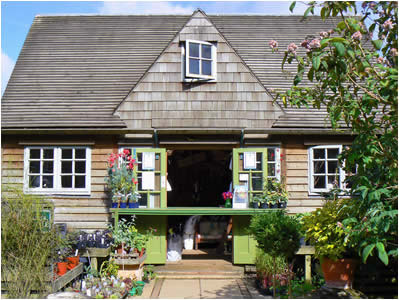
East Ruston Old Vicarage entrance |
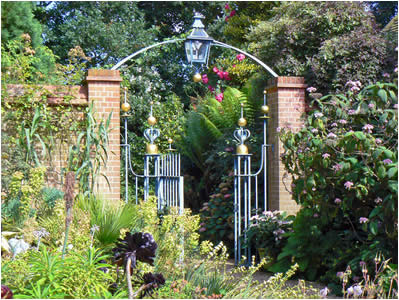
East Ruston garden entrance courtyard |
Next to the entrance is the North Garden. This area is a complete contrast to the entrance court which is hot and dry. Here we enter a green jungle containing palm trees, tree ferns and two magnolias. |
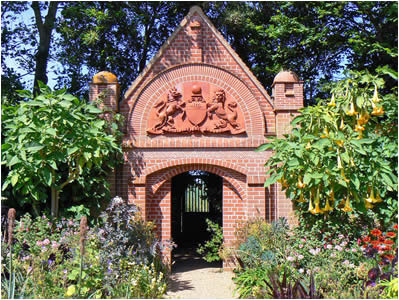
East Ruston North Garden |
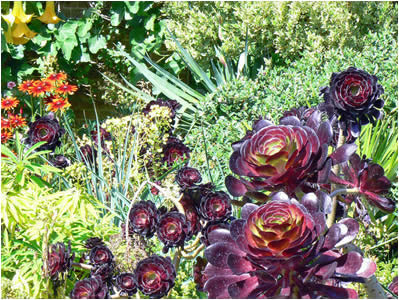
Planting in the North Garden |
Through a doorway we come to the Dutch Garden, with its greenhouse and wonderful plants. This area of the garden has formal box edged flower beds, with box balls at the corners and obelisks. It has become the home to some stunning pot planting during the summer months. |
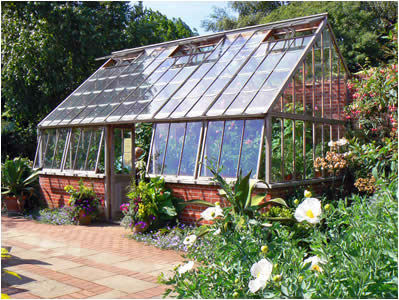
Greenhouse in the Dutch Garden |
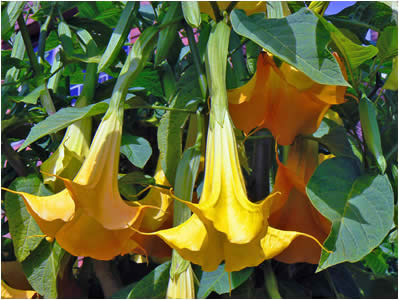
Yellow trumpet flowers |
Through a brick archway we come to the house, which has a number of urns and other kinds of pots on the terrace. |
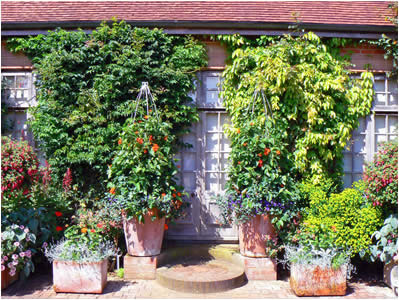
Pots and urns on the terrace |
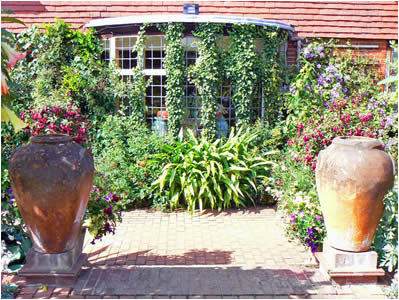
Plant pots by the house |
| |
To the front of the house is a formal lawn and ten sentinel obelisks of yew, known as Kings Walk. To the sides are areas leading to other parts of the garden. Kings Walk leads up to the Pavilion, through a couple of gateways. |
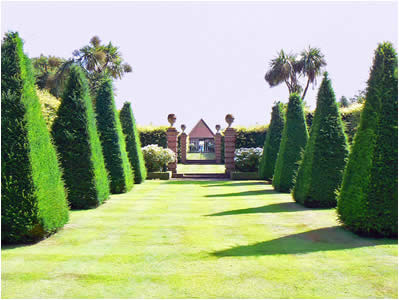
Kings Walk, obelisks of Yew |
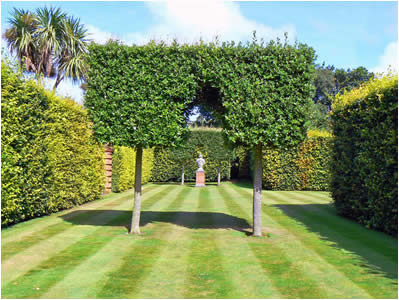
Lawns at East Ruston gardens |
| |
As we turn around, we see some great views back towards the house, along Kings Walk and the pots on the terrace. |
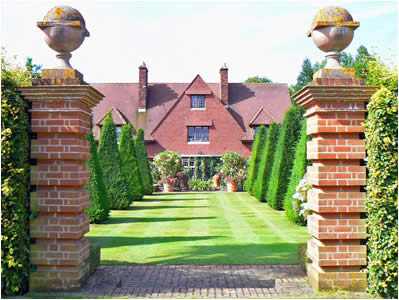
View of the house along Kings Walk at East Ruston |
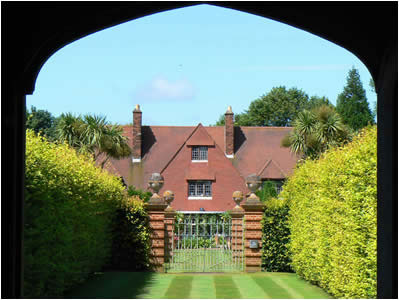
East Ruston house gates |
The square Pavilion, with its brightly coloured interior, houses a collection of aerial photographs of the garden taken over the years. |
Steps lead to the south facing terraces of the Mediterranean Garden. This garden contains plants originating from the Canary Islands and Mexico. |
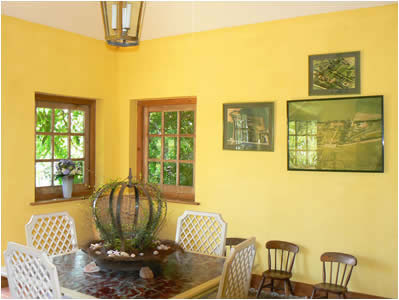
The Pavilion at East Ruston Old Vicarage |
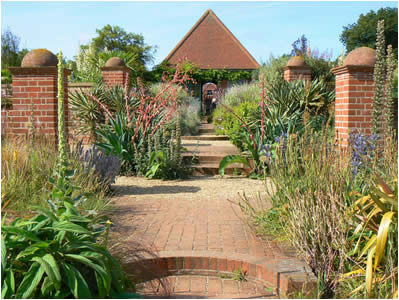
The Mediterranean Garden |
Moving through arches to the sides of Kings Walk, we pass into and through a number of different areas of the garden, each with their own unique theme, from topiary to colourful borders. |
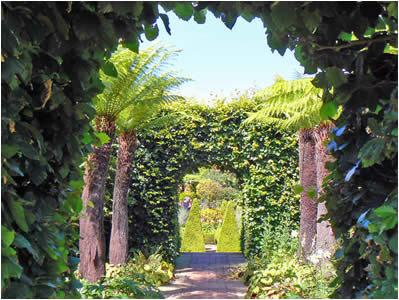
Garden arches |
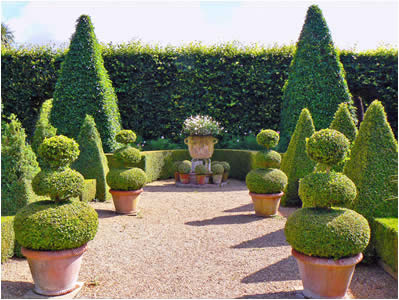
Topiary at East Ruston |
| |
|
| The red and purple border contains a wooden summer house with a shingle tiled roof and admire the view across the main lawn towards the Dutch garden. |
In the tree fern garden, sixteen tree ferns have been planted in a rigid formal design. At one end is a seat where you can sit and enjoy a well earned rest. |
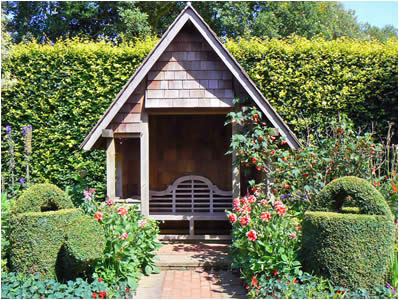
Red and purple border, with wooden summerhouse |
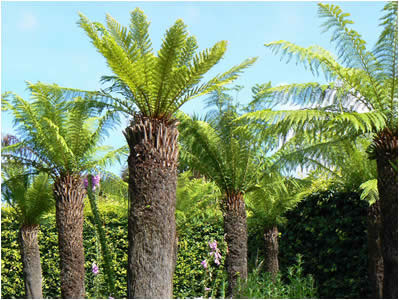
Tree Fern Garden |
Other areas of the garden include the Californian Border, designed to resemble parts of the Arizona, where it only rains once or twice a year. |
Scattered amongst the gardens are a couple of meadow fields, planted with masses of yellow and blue flowers, with a few red poppies thrown in! |
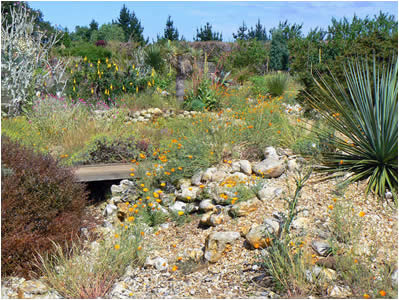
Californian Border, resembling Arizona |
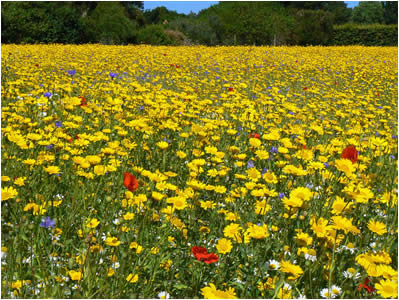
Meadow of yellow flowers |
The sunk garden was constructed by digging a slope to provide shelter from the winds. At the heart of this garden is a water filled basin with pink water lilies and a sculpture. Around the edges are raised beds with a variety of plants, providing interest at every month of the year. |
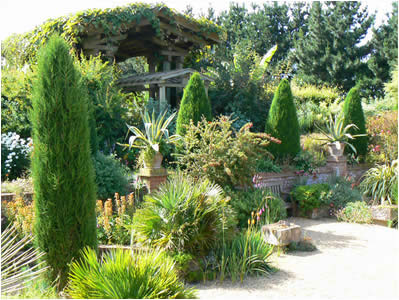
The Sunk Garden |
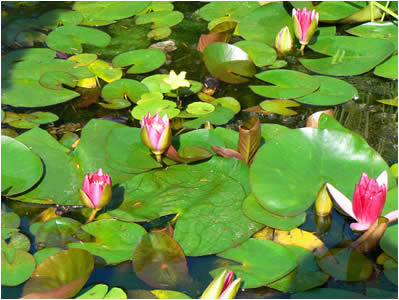
Pond with pink water lillies |
| |
| A large vine-hung pergola stands between the sunk garden and the exotic garden. The exotic garden contains two raised ponds; one containing fish and the other a tall fountain, resembling a waterspout. |
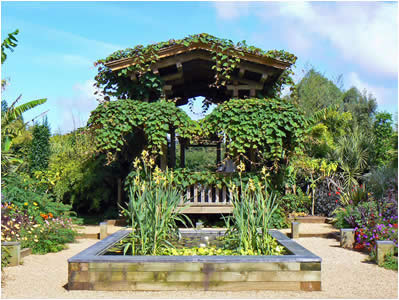
Pergola covered in Vine in the Exotic garden |
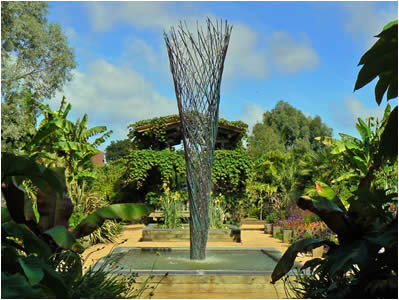
Exotic garden pond, with waterspout fountain |
| |
The surrounding beds are planted to give an exotic feel and include banana and a number of colourful tender annuals, grown from cuttings. |
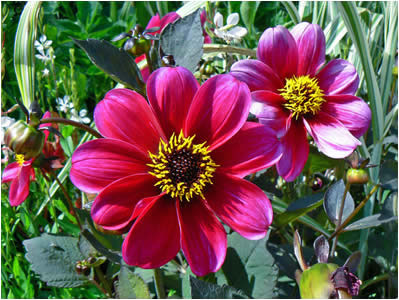
Purple flowers |
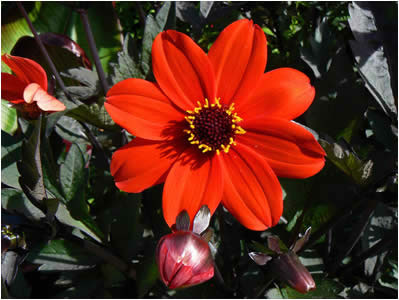
Red flowers |
One interesting statue is the Paper Lady by Bill Cordaroy - she stands on the edge of the West Field and Woodland Garden, which is criss-crossed with gently meandering paths. This garden has an extremely long season, starting with Snowdrops in February. The garden continues with an extensive collection of Hydrangeas and finishes with a fanfare of autumn colours from Acers. |
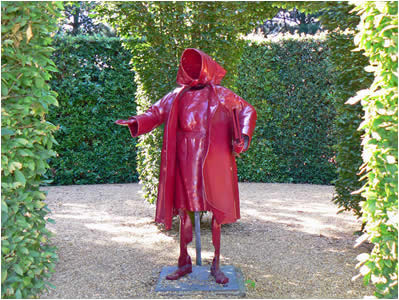
The Paper Lady by Bill Cordaroy |
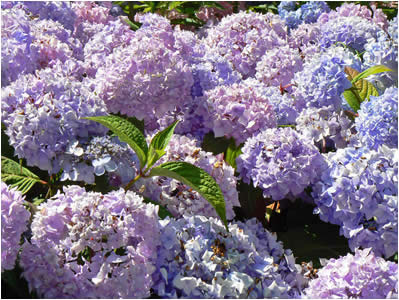
Hydrangeas in flower |
The wildlife pond contains a large population of golden minnows, frogs and newts. A jetty and seat allow you to enjoy the view over towards the unusual statue. |
The East Field is an area of 12 acres, that is currently being planted with trees. This will eventually become a woodland garden, providing shelter for exotic plants. |
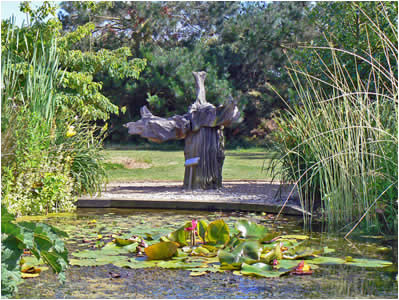
Wildlife pond with statue |
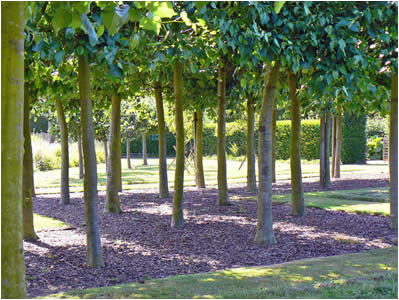
The East Field and woodland garden |
Two outstanding features of the gardens are the use of Happisburgh Church and Lighthouse as "borrowed views" in the Apple Walk and Winter Garden. Both the church and the lighthouse appear closer than their actually are and the views are framed by tall poplar trees and a porthole cut in a pine. |
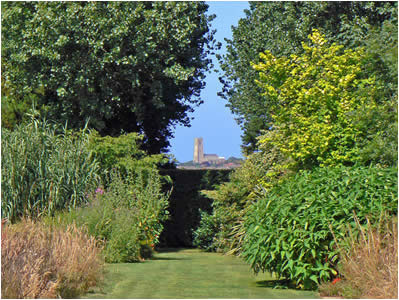
Happisburgh Church view from East Ruston Gardens |
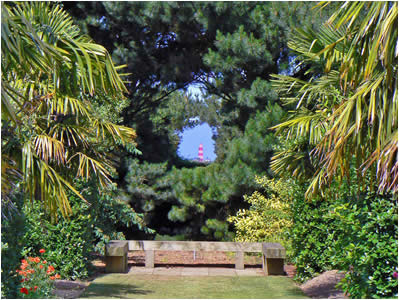
Happisburgh Lighthouse view from East Ruston Gardens |
| Nearing the end of our tour, we pass back towards the house and an office door, with lots of pots in the tea garden. |
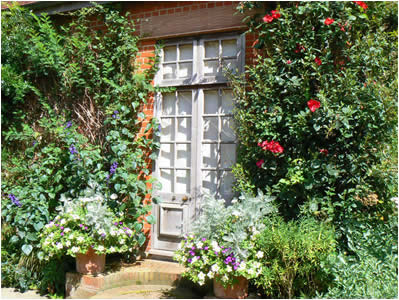
Office door |
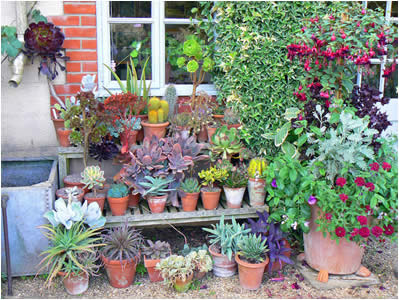
Pots in the Tea Garden |
The tea garden is a place to recover and enjoy a cup of tea with a cake or biscuit. |
There is also an area selling some the many plants on display in the garden. |
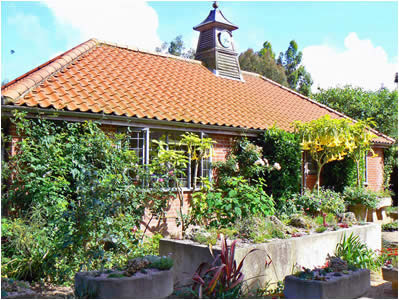
The Tea Garden |
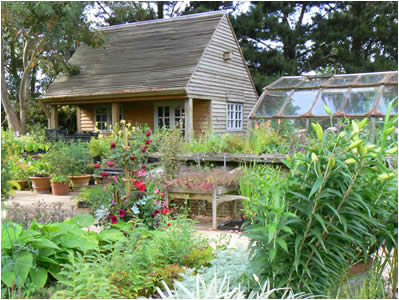
The plant shop |
East Ruston Gardens summary of the what to SEE and DO
|
 Many linked and themed gardens |
 Exotic Garden and Sunk Garden |
 Views of the house and pavillion |
 The framed views of the lighthouse and church |
 Tea Rooms and Plant sales |
|
|
Our Verdict |
East Ruston Old Vicarage is an amazing place. The gardens compete with the best in the country and there is so much variety. Fully recomended. |
Readers Comments |
When you are planning your outing to East Ruston Vicarage Gardens choose a warm sunny day and allow for many, many hours to wander around these absolutely wonderful grounds. We were a party of six which included one 'none gardener' but even he admitted to being quite impressed and when we return to Norfolk for next years family get-together holiday we will be back again but for a day, not just an afternoon - brilliant! |
|
|
NEARBY PICTURE TOURS |
|
|
|
|
|
|
|
|
|
MORE OF OUR WEBSITES |
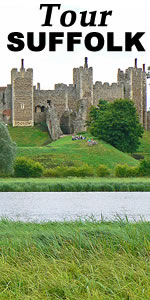 |
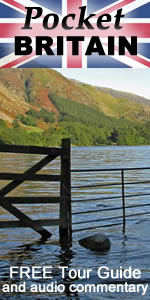 |
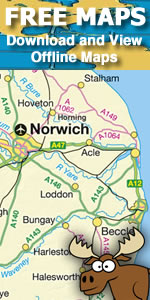 |
| |
|

